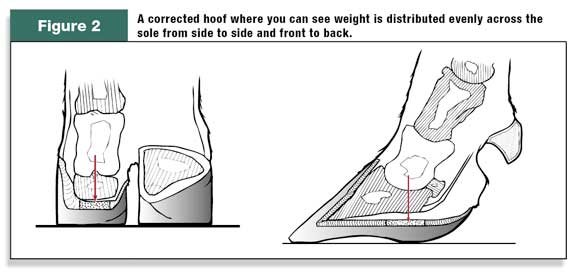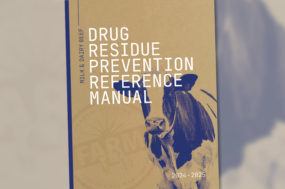In today’s modern dairies, one of the most fascinating relationships is between rumen health and hoof health. This is a two-way relationship; first is the effect that hoof health or infectious lameness can have on feeding behavior and the impact changes in feeding patterns have on rumen health. Second, nutrition and rumen health can directly affect hoof health through subclinical acidosis and laminitis.
When a cow has an infectious lameness such as hairy footwart or footrot, her feeding behavior can change because she is less willing to make frequent trips to the feedbunk. She then starts eating larger meals in order to maintain daily feed intakes. When a cow eats a large meal, she may not be able to produce enough saliva to buffer the rumen. Her inability to buffer the rumen kicks off the cascade of events that in the end has been shown to cause laminitis.
Nutrition and feed management can also have a tremendous impact on lameness. Even though more research is needed to clarify some of the mechanisms of laminitis in cows, we do know that excessive sugars or non-structural carbohydrates can cause a prolonged drop in rumen pH. Feed delivery at uncertain times, overstocking and uneven feedbunk distribution can all have a similar effect to an unbalanced ration. However, the end result is the same – a low rumen pH that may go unchecked and an increased risk of subclinical acidosis. Subclinical ruminal acidosis (SARA), is a chronic condition that causes changes in hoof blood flow and weakens hoof connective tissue, causing the toe to rotate. This causes the cow to bear most of her weight in a small area of the claw. We often see these cows presenting themselves on the hooftrimming table with sole ulcers, abscesses and other conditions associated with laminitis.

Figure 1 indicates what over-growth can do to the position of the bone and furthermore, how repositioning leads to heel ulcers. Figure 2 is the corrected hoof where you can see weight is distributed evenly across the sole from side to side and front to back.
The following checklist can be used to help improve rumen health and hoof health or to identify opportunities at your dairy.
Consider the four Cs of hoof health and rumen health: 
1. Consistent plane of nutrition – ration design and delivery
• Regardless of what ingredients you are feeding, don’t break the basic rules of rumen fermentation. These rules are centered around maintaining the health of some of the most important workers at the dairy: the rumen bugs.
• Water. Moisture of the ration can play a role in the amount of sorting between forage and grain. Adding water to dry diets can help maintain the true TMR we set out to deliver at each feeding. Furthermore, diets too high in moisture can reduce the rumen mat, creating drops in the rumen’s pH. It is important to keep the total dry matter of the TMR near 50 to 55 percent dry matter at all times.
• High fat may alter rumen bug populations; it may physically coat feed in the rumen and prevent fermentation of fiber altogether in severe cases. Unsaturated fats at certain levels can be directly toxic to rumen bugs and can depress butterfat production in some cases.
• High/unbalanced fermentable carbohydrate load can alter rumen populations, lower rumen pH, create a subclinical acidosis problem, cause rumen wall damage, lead to escape of bacteria to the circulatory system and negatively impact hoof health.
• Check feedbunk distribution. Poor feedbunk distribution can lead to slug feeding.
• Check TMR at the end of the day. TMR cleanout should look very similar to freshly delivered TMR. If TMR looks significantly different, sorting may be excessive.
• Check ingredient dry matter, especially wet ingredients. Variable TMR dry matter may result in variable grain/forage intake ratios. The simplest dry matter quality control is when the feeder notices a change in the weight of a scoop of an ingredient such as corn silage. A Koster Tester or microwave will help you quickly determine a change in dry matter and make the appropriate adjustments.
• Check trace minerals. If your herd is experiencing foot health challenges, increasing the zinc and biotin levels in the diet can improve hoof health. Work with your nutritionist to determine the optimum levels for your herd.
2. Cow comfort
• Check your cow “time budget.” The amount of time a cow is eating, walking to the parlor, standing in holding pens and locked up or locked away from her resting area, can change feeding behavior and may also directly affect the incidence of laminitis. The lactating dairy cow needs 12 to 13 hours of resting time. Our best clients manage the daily routine around the cow’s time budget. A good rule of thumb is for cows to spend 60 to 70 percent of their time lying down chewing their cuds.
• Keep lanes and corrals dry. A constantly wet environment increases the risk of infectious hoof diseases. Cows standing in a muddy wet area for extended periods of time will lead to digital dermatitis and heel erosion. This can snowball into other infectious foot diseases.
• Poor feedbunk access may cause changes in eating behavior, resulting in fewer large meals and poor rumen function and incomplete digestion of feeds. Furthermore, this may cause a lot of pushing and shoving, leading to increase of injury.
• Rough handling. Studies have shown that cows will avoid hoof injuries if allowed to walk at a “normal” pace into the milk barn.
• Poor heat abatement can lead to panting and reduction in the volume of saliva delivered to the rumen for buffering. In addition, heat stress causes cows to stand for longer periods of time, possibly causing biomechanical damage to the foot.
• Poor detection of cows to be trimmed and allowing long toes to go untrimmed. This physical change affects the anatomy of the hoof and focuses pressure on small areas, which can lead to ulcers and infections.
• Check stocking density. High stocking rate alters feeding behavior and resting time. Every cow needs to be able to eat and lay down to be the most efficient at producing milk.
3. Control of infectious lameness
• Get aggressive with any current problem you have. Work with your foot trimmer or veterinarian to identify the correct bath for the problem you have. Footbaths are not one-size-fits-all.
• Hairy footwart must be controlled at all stages of lactation. Dry cows and youngstock need to be monitored for these contagious foot diseases to prevent it from spreading to the lactating herd. During the dry period if the youngstock share a fenceline with older animals it may be appropriate to run both groups through a medicated footbath in order to keep contagious bacteria in control.
• Once fresh, the herd should see a clean footbath treatment three to seven days a week to keep infectious bugs in control. The more prevalent infectious lameness is, the more days of treatment per week you will need.
• Emphasize footbath cleanliness with your employees. A dirty bath causes more harm than no bath at all. It is important to rotate the start of a new footbath so all groups get to be treated with a clean footbath.
4. Critical timing
• At the end of lactation is no time to slack on the footbath. Set her up for dry period with a clean, healthy hoof. At dry-off each cow needs to see the trimmer for proper foot health.
• Check dry-off trimming routines. Proper angle trimming and treatments should be administered. Her hoof will grow slower in this period but that doesn’t mean we don’t look at her for several weeks. Frequently check for lame cows in dry pens and treat immediately.
• Check mid-lactation trimming routines. During this part of her lactation her hoof has grown fast and has the highest susceptibility to problems. If for nothing more than to reshape and get her standing evenly on her toes, mid-lactation table visits are an optimal time to clean up any overgrowth and treat issues before they become problems.
• Check your trimming days per year. Schedule the correct number of trim days per year. A good rule of thumb is one day per 20 cows per year.
• Record keeping. It is important to have your hoof trimmer track all infectious and non-infectious disease during the time of trimming. The identification of the type of foot problem will allow your team to find the root cause.
Foot health is a critical part of any dairy operation’s success. A high-producing dairy cow is like a high-performing athlete. Just a minor foot irritation will limit their performance. It is important to have all key stakeholders be a part of the plan to improve the hoof health of your dairy. We like to see the herd manager, veterinarian, nutritionist and hoof trimmer discuss and review the current hoof health status and make an action plan for the coming year. PD
Enrique Schcolnik
Veterinarian
Progressive Dairy Solutions
dre@progressivedairysolutions.com




